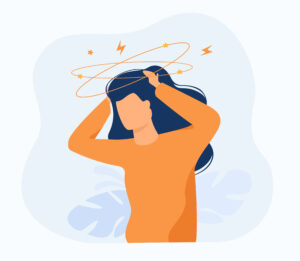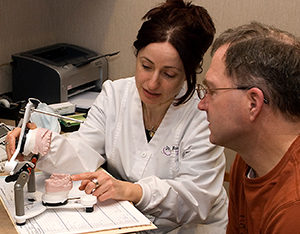
People are often taken aback when learning the source for certain health conditions is found to be related to their jaw joints. Read on for a look at some of these. I have a feeling some may surprise you.
Headaches can be an interference to one’s day. However, the pain from migraines is much worse on a number of scales. Migraines typically last longer than 4 hours with pain that seems unbearable, causing light sensitivity and more intensity with certain odors and/or noise. The miserable pain can cause nausea or vomiting and throbbing head pain that’s typically located on one side of the head.
According to the World Health Organization, migraines affect nearly 12% of the population, resulting in more than $20 billion a year in medical costs and lost productivity from work.
While there is no debate about the debilitating effects of migraines, a definitive cure does not exist. However, migraines may be minimized or reduced in frequency when their true origin has been detected. Fortunately, treatment does not necessarily require harsh medications or unending therapy. In many cases, migraine pain may be halted – sometimes for good – by a dentist trained in Neuromuscular Dentistry.
We often see migraine sufferers who have sought relief for years, even decades. Some have spent thousands of dollars, traveling to see one specialist after another. Because medical specialists focus on contributing factors related to their specific area of expertise, this localized approach to diagnosis doesn’t always result in effective treatment. In some cases, a level of relief may occur without the patient truly feeling the problem has been pinpointed and resolved.
When a neuromuscular dentist steps into the picture, it brings a unique skillset that covers the complex integration of head and neck muscles, jaw joint alignment, facial structure and muscles, bite alignment and the harmonious function necessary for all components. Without these structures working in unity, stress and strain can develop and cause frequent headaches and migraines.
However, headaches and migraines are not the only problems associated with the jaw joints.
While there are a number of causes, let’s begin by clarifying the difference between being “dizzy” and what is known as vertigo. While dizziness can cause one to feel off-balance, light-headed, unsteady, or faint, vertigo is a sensation of spinning, typically along with some symptoms of dizziness.
Vertigo’s symptoms actually come from the tiny structures in the inner ear, which have a major role in our ability to stay balanced because of the vestibular system.
The vestibular system is a sensory system responsible for providing the brain with information about body movement and its position in relation to the environment (helping us to adjust to things such as climbing stairs or getting out of a car). It is in this system where the link between the inner ear and brain exists.
The brain integrates this information and signals the muscles on how to maintain balance. This connection keeps us able to maintain balance for overall steadiness in things like walking or while standing.
A disruption of the vestibular system can occur from an injury, illnesses that affect the inner ear, or certain conditions that inhibit the system’s ability to function, which in turn can lead to an inability to maintain balance.
There can be a wide range of causes of having dizzy spells or vertigo, including:
Dizziness or vertigo are related to the jaw joints because of the close proximity. Positioned just in front of the ears on each side of the head, the temporomandibular joints (TMJ) are where the lower jaw and skull connect. They are what enable the jaw to move in speaking, eating, and even yawning. There is even some movement when swallowing.
Obviously, these joints are in motion a lot throughout our lives and move fluidly and harmoniously. However, these joints can become inflamed when something causes an imbalance. When inflammation in these joints reaches the ears, sensors in the inner ear disrupt the brain’s signals about your body’s position and movement. Hence, your sense of balance becomes off-kilter. The results can be a loss of balance or feeling dizzy, accompanied by any of the symptoms as mentioned previously.
A particular health correlation that’s getting more attention is the connection between obstructive sleep apnea (OSA) and TMJ (jaw joint) disorder. Results from a number of studies are showing a close relationship between the two disorders.
In one study, one-third of participants with TMJ Disorder (TMD) also suffered from obstructive sleep apnea. Through advanced imaging technology, researchers have become better able to hone in on how the connection exists.
In another study, 75% of patients who were diagnosed with sleep apnea also reported pain associated with their jaw joints. This has prompted some dentists and physicians to advise their TMD patients to be tested for sleep apnea. For many, an oral appliance that resolves TMD can have dual advantages for sleep apnea sufferers.
It is felt that the connection hasn’t been obvious before because the “average” patient with each ailment doesn’t share much of a similar make-up. While age is a risk factor for both genders, sleep apnea tends to be experienced by older men (who have a 2 to 3 times higher rate of developing the disorder). Compare this to the average TMD sufferer, who are generally women in the 25 – 50 age range.
Too, the symptoms are very different. While sleep apnea suffers typically snore and are fatigued throughout the day, prominent symptoms of TMD may be headaches, ear ringing, or dizziness.
Along with these factors are misdiagnoses that often occur. When an individual complains of headaches, these can easily be presumed as tension headaches. Common treatment is often in the form of medications that simply mask the pain, not resolve it. Even though headaches are a common symptom of TMJ disorder and also occur in sleep apnea sufferers, the marriage of the two conditions is frequently overlooked as the source.
By treating one problem, you may very well resolve the other. And, in many cases, our patients find that treatment is far less involved than they anticipated and like that treatment can occur without drugs that are depleting and hamper awareness.
Because the symptoms of fibromyalgia have been noted as similar to the symptoms associated to TMJ disorder, studies are looking further into the relationship between the two.
Fibromyalgia is a condition that causes widespread pain, sleep problems, fatigue, and emotional and mental distress. While it affects about 4 million U.S. adults, it’s cause is not known (https://www.cdc.gov/arthritis/basics/fibromyalgia.htm)
According to the Centers for Disease Control & Prevention (CDC), people with fibromyalgia may be more sensitive to pain than people without it due to “abnormal pain perception processing.”
The most common symptoms of Fibromyalgia are:
Compare these to typical symptoms of TMJ disorders:
As a Neuromuscular Dentist, I have seen many patients over the years who have gone from specialist to specialist for help, only to feel their problem was not resolved. Some are placed on medications such as muscle relaxers that cause the individual to feel sleepy, depleted of energy and lack of alertness.
Because some of the symptoms of TMJ disorder are seemingly unrelated to one’s bite alignment, it can mask itself as issues related to neurological, ear, eye, and muscles. Some people are even told “it’s all in your head,” being brushed off as mental issues or put on anti-depressants to “treat” it.
Using neuromuscular dentistry, I’ve treated many patients who have suffered for years – even decades – with TMJ disorder. Some have gone from specialist after specialist, only to get very little to no relief. Others had costly tests and expensive therapies, only to experience minimal (if any) results.
In our Shelby Two dental office, we have incorporated some of the most advanced diagnostic technology in the U.S. when it comes to diagnosing TMJ issues. In addition to specific testing of the muscles at various points in bite alignment, we use highly-advanced cone beam imaging technology.
This low-dose radiation 3D imaging reveals airway passages, jaw joint structures, surrounding bone depths and muscle/tissue connectivity. These intricate views take the guesswork out of if a TMJ disorder truly exists and where the issue lies.
Another feature, the BioPak system, records the functions and congruity of the upper and lower jaw, jaw joints, and associated muscles at various ranges. This information is a significant aid in proper diagnosis and treatment planning for TMJ dysfunction, sleep disorders and craniofacial pain. It is also used to evaluate patients for restorative, orthodontic, denture, implant and ‘bite’ reconstruction.
Additionally, TekScan™ or (T-Scan) Digital Occlusal Analysis is highly beneficial in TMJ disorder diagnosis. Unlike the common method to check one’s bite through ‘articulating paper,’ which fails to indicate when and with how much force, T-Scan is the only technology that shows the measured force and the timing of occlusal surfaces coming together.
Combining the BioPak and T-Scan can paint a clear picture of the patient’s bite with the level and timing of force on individual teeth and occlusal stability of the overall bite.
Occasionally, the solution is as simple as minor tooth reshaping to adjust bite alignment. In some cases, adjusting crown height or replacing improperly positioned dental restorations can solve the problem. Some patients need orthodontic realignment to adequately correct the disparity in bite alignment that leads to jaw joint disorders and muscle strain.
Do the symptoms above sound familiar to you? Let’s discuss your needs during a no-cost private consultation. During this time, I’ll explain the process that provides clear, concise answers related to your bite alignment.
Here, in our Shelby Twp dental office, we are always pleased to welcome new patients. Call 586-739-2155 to schedule. Or, simply tap here. You are also invited to get to know our unique Macomb County dental office through some brief videos: